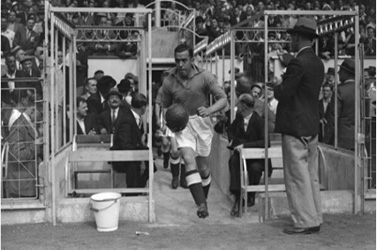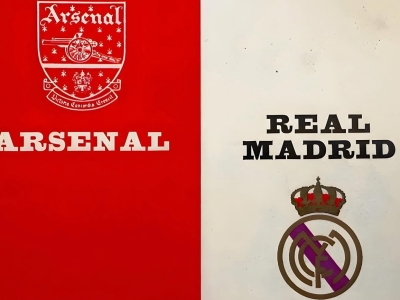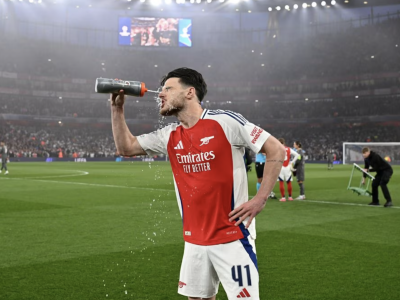After the retirement of Sir Alex Ferguson in 2013 a Man Utd supporting colleague of mine - only old enough to have known football during the Premiership era - said he was confident in the abilities of David Moyes to follow the old Govan shop steward at Old Trafford because he had (in his words) ' built Everton 's best ever side'. If you've only ever known football during the Premiership era it's easy to overlook the fact that Everton have actually won nine titles during their history - the fourth highest ever tally and the same number in which the last two Premiership winners, Chelsea and Man City, have won combined.
Everton were founded in 1878 as St. Domingo's after the Methodist church of the same name within the Everton area of Liverpool to enable the people of the parish to play sport all year round (the club played Cricket in the summer). The name of Everton was adopted when people outside of the parish began to participate. The club’s crest features Prince Rupert’s Tower – a local landmark also known as ‘Everton Lock-up’ which was an overnight holding place where local drunks and criminals were taken by parish constables – which sits atop of Everton Brow, a hillside which runs off of St Domingo Road in Liverpool. Beneath the crest is the Latin phrase of ‘Nil Satis Nisi Optimum’, which translates into English as ‘Nothing but the best is Good enough’.
Everton were also founder members of the Football League in 1888 and of the original twelve clubs have been the most historically successful. They've spent more seasons in the top tier than any other club, with just four seasons spent outside of it. As a result, Arsenal have played more League fixtures against Everton than any other side. Everton’s first visit to Woolwich Arsenal came in 1905, which Arsenal won 2-1 with a goal from former Liverpool player Charlie Satterthwaite, who also scored Arsenal’s first top flight goal against Wolves eight months earlier. The Evertonians were Merseyside's original club and, as told in my piece on Liverpool back in August, were the original occupants of Anfield before a dispute with the landlord led to their eviction in 1892 and the formation of their Merseyside rivals as a direct result.
The club’s nickname of the ‘Toffees’ or ‘Toffeemen’ actually derives from their time at Anfield and the move to their new ground on the other side of Stanley Park - Goodison Park – which in 1892 became Football’s first ever purpose built stadium. ‘Ye Anciente Everton Toffee House’ located close to Anfield became famous for selling huge amounts of confectionery to the crowds which amassed to watch Everton. When the club moved to Goodison, a rival confectioner called Mother Noblett’s Toffee Shop created the ‘Everton Mint’, which was the same toffee but wrapped in a black and white crunchy outer shell, which were Everton’s home colours at the time. As a gimmick the club arranged with Mother Noblett’s to allow an attractive girl to throw free Everton Mints to the crowd prior to every match, permanently aligning the club to their product. The patent for the Everton Mint has since been sold to the Bassett sweet company to mass produce on an industrial scale.
The year prior to eviction in 1891, Everton became Merseyside's first League champions. The earliest Merseyside Derby caught on camera came in 1902, as seen here. Everton won their first FA Cup in 1906 secured by beating Newcastle 1-0 at Crystal Palace, though lost the final the following season against The Wednesday of Sheffield. Everton were also the last side to win the League Championship before football ceased due to the First World War in 1914/15, pipping Oldham Athletic by just one point. Everton’s first sustained period of success however came after the late 1920s, inspired by the signing of William 'Dixie' Dean from Tranmere in 1925 (in the un-PC days of the 1920s he acquired his nickname because his peers thought his dark hair and dark complexion made him look like an Afro-American from the deep south of the USA).
Dean fired Everton to the 1927/28 league title with a record sixty league goals (still a top flight record 87 years later). Dean achieved the record by scoring an incredible seventeen goals in the final nine games of the season. The record of fifty nine goals was set a year earlier by Middlesbrough’s George Camsell and was broken with a hat-trick in Everton's final league fixture of the season at Highbury, away to Arsenal, which ended in a 3-3 draw. This game was also the final game played by Arsenal forward Charles Buchan, however he found himself upstaged by Dixie on this day. This here is an interview with Dixie Dean for the Guardian Newspaper half a century on in 1977.
Despite their title win in 1927/28, within two season Everton would finish rock bottom and be relegated to the second tier for the first time in their history at the end of the 1929/30 season. The Toffees however would only remain there for just one season, winning promotion back to the top flight in 1930/31 by winning the Second Division Championship by seven points at a time when a winning side were awarded two points. Their form continued on promotion, here battering Chelsea 7-2 in November and securing the league title in their first year back in the top flight, pipping Arsenal to the title by two points (Arsenal’s 1931/32 season is covered here in an article which I wrote for the Online Gooner back in 2013.
Everton’s trophy winning form carried on into the next season, despite dropping to eleventh in the League the Toffees won the 1933 FA Cup Final against Manchester City 3–0. The following year Everton were covered in Pathe’s series on top level sides in training, who along with Dixie Dean also included the balding 37 year old Warneford Cresswell (who the narrator hilariously describes as ‘regularly celebrates his twenty first birthday’) and goalkeeper Ted Sagar who was an Everton regular for over two decades. Between their title win in 1931 and 1938, Everton only finished in the top half of the table just once finishing eighth in 1934/35. The only inter-war visit to Highbury by an Everton side to be caught by the newsreel was the opening fixture of the 1936/37 season, which Arsenal won 3-2 with goals from Alex James, Eddie Hapgood and Ray Bowden with Dixie Dean and Alex Stevenson scoring for the Toffees.
Everton were the last side to win the League Championship before the outbreak of World War Two, winning the title by four clear points, as well as reaching the FA Cup Quarter Finals, caught in action here in the Fifth round against Birmingham and inspired by the signing of Tommy Lawton from Burnley who replaced Dixie Dean and bagged sixty five goals in just eighty seven appearances for Everton. Lawton however, in his own words in this interview with Granada TV in the early 1980s, would spend the happiest years of his career at Arsenal, though as with most footballers of his era would not be handsomely rewarded financially from his successful career. This interview included a meeting with a modern day Footballer in Trevor Francis, then of Man City, who would remark how fortunate he was to be playing in such an era but that the era of players earning big money ‘couldn’t go on for ever’ (nearly thirty five years on, and even the mediocre ones are earning much more than Francis, let alone Lawton!).
In the years immediately following the Second World War Everton would face decline, finishing in the bottom half of the table for four years out of five. During this period, Everton would sell Joe Mercer to Arsenal, after he fell out with the club. An Everton visit to Highbury would also be caught by the newsreel in 1949/50 with Arsenal winning 5-2 with two goals from Peter Goring, two for Reg Lewis and one for Don Roper. That same season Everton would miss out on a Wembley final against Arsenal through losing the Semi Final to neighbours Liverpool 0-2 at Maine Road. The following season Everton would finish rock bottom of the old First Division and would be relegated to the second tier for only the second time in their history, remaining there for three seasons. Everton’s lowest ever finish came in 1952/53, as Joe Mercer lifted the League Championship as Arsenal captain, his old club were languishing in sixteenth place in the second tier.
The following season however the Toffees would return to the top flight as runners up, just as their neighbours Liverpool were on their way down to the second tier where they would remain until 1962. The next Everton visit to Highbury caught on video would be Arsenal’s 3-1 defeat of the Toffeemen in January 1959, with two goals for Vic Groves and one for Jimmy Bloomfield. Twenty Two months on, Arsenal would secure another victory before the cameras with a 3-2 win emanating from a David Herd hat-trick.
Everton’s return to prominence came with the introduction of the founder of Littlewoods Pools and mail order catalogue empire, John Moores, who invested in the club in 1960 just as the maximum wage was to be abolished and the retain and transfer system came to be challenged. The following year he sacked manager Johnny Carey while the two were riding a London taxi to an FA meeting (apparently the origin of the phrase ‘Taxi for….’ when shouted at an under fire manager) and appointed Harry Catterick in his place. The Moores family also held shares in Liverpool FC, who at roughly the same time appointed Bill Shankly as manager. At John Moores’ insistence, Liverpool appointed Eric Sawyer of the Littlewoods Group to the board, who was considered a close ally of Shankly in his transformation of Liverpool FC.
The City of Liverpool has always had a side in the top tier of English football since the inception of the Football League in 1888, however there would be eleven years without a league fixture between the two sides between 1951 and 1962. The first Merseyside derby in eleven years in September 1962 ended in a 2-2 draw at Goodison Park. John Moore’s investment paid off with Everton securing their first post-war title in 1962/63, with signings from smaller clubs such as Gordon West from Blackpool, Alex Young from Hearts and Tony Kay from Sheffield Wednesday. That season however, Arsenal took all three points with 4-3 win and goals from Joe Baker, Johnny McLeod, Alan Skirton and Geoff Strong for Arsenal, while Tony Kay, Roy Vernon and Alex Young were on target for Everton. By the end of that calendar year, on Everton’s return to Highbury the following season Arsenal duly thumped the Toffees 6-0, with goals from George Armstrong, two for Joe Baker, two for George Eastham and one for Geoff Strong.
Everton finished third that season, five points behind rivals Liverpool who won the 1963/64 League Championship. By mid-April of 1964 however Everton would be rocked by the involvement of star player Tony Kay in the great match fixing scandal along with his former Sheffield Wednesday team mates Peter Swan and David ‘Bronco’ Layne, as well as ten other professional players who were later to serve jail sentences for their involvement. The great match fixing scandal of 1964 would later be dramatized in 1997 in a BBC play called ‘The Fix’ which starred Steve Coogan and Ricky Tomlinson, as well as written and directed by Paul Greengrass who later went on to direct the Bourne Supremacy and subsequent other films from the Bourne action series. Ironically, Everton would return to trophy-winning ways two years later coming back from two goals down against Kay’s old side Sheffield Wednesday to win 3-2, along with a hilarious one man pitch invasion by a jubilant middle aged balding Evertonian eventually upended by a rugby-tackling policeman.
Eighteen months on and a 2-2 draw at Highbury between Arsenal and Everton would be caught by the Match of the Day cameras. This game would also feature heavily in the Ken Loach directed Wednesday Play ‘The Golden Vision’, screened on the BBC in April 1968. In this era of ‘scripted reality’ shows such as TOWIE and Made in Chelsea, it’s easy to forget that back in the 1960s, the genre of the Docu-Drama did something similar in mixing the production techniques of current affairs documentaries (featuring interviews with Harry Catterick, his assistant - and future assistant to Terry Neill at Highbury - Wilf Dixon, as well as Everton stars Alex Young, Ray Wilson and Brian Labone), with that of drama. Unlike the ilk of TOWIE however, rather than using talentless fame hungry non-entities the ‘Golden Vision’ actually used Equity card holding actors such as Ken Jones (who went on to star as ‘Horrible’ Ives in Porridge) and Bill Dean (who went on to star as Harry Cross in Brookside). The ‘Golden Vision’ was also scripted by Gordon Honeycombe, who later went on to find wider fame as a newscaster on ITN and TV-AM and sadly passed away a couple of weeks ago at the age of seventy nine after a battle with Leukemia.
Everton returned to Wembley in the FA Cup Final in 1968, but were defeated 0-1 to West Bromwich Albion. Everton would kick off the 1969/70 season at Highbury, inflicting a 0-1 defeat on Arsenal. The Rodgers won plaudits for their style of football in 1969/70, with the midfield ‘holy trinity’ of World Cup winner Alan Ball signed from Blackpool, the recently departed Howard Kendall and the ‘White Pele’ Colin Harvey, as well as Joe Royle up front. The Toffees managed a 3-2 win over Leeds at the end of August, a 3-1 win over Sunderland in October, however after a calamitous 0-3 defeat at home in the Merseyside derby Catterick had barred the TV cameras from Goodison as to avoid opposition managers analysing Everton’s style of play. In the title run-in, Everton got their revenge on Liverpool with a 2-0 win at Anfield and the title secured with a 1-0 win over West Brom at Goodison Park in April.
Everton’s return to Highbury as defending champions in 1970/71 brought a 4-0 win for Arsenal in October 1970 with two goals from Ray Kennedy, a Peter Storey penalty and one from Eddie Kelly. Two weeks later Everton would be involved in a piece of history by winning the first ever penalty shoot-out in the European Cup against Borussia Monchengladbach. Again as in 1950, the privilege of meeting Arsenal in the 1971 FA Cup Final was decided by an all Merseyside Semi-Final won by Liverpool 2-1 at Old Trafford. The look of despair on Alan Ball’s face as Liverpool put away their second reflected the Toffees decline. The next visit of Everton to Highbury on New Years’ Day of 1972 coincided with Alan Ball’s debut for Arsenal against his old club, which ended 1-1 with a goal from Peter Simpson for Arsenal and Howard Kendall scoring for Everton.
Between 1971 and 1973 Everton would finish in the bottom half of the table for three seasons in a row leading to Harry Catterick’s resignation in 1974. Everton’s decline coincided with Liverpool’s rise from the early to mid-1970s, with Everton after beating Liverpool 1-0 at Goodison in late 1971 failing to score another win against their rivals until October 1978, when an Andy King goal secured a 1-0 win over the red half of Merseyside also ending Liverpool’s run of 23 League games unbeaten. Everton’s return to the big time however would not materialise until the prodigal return of one of the Toffees’ midfield ‘Holy Trinity’ in 1981, to return the club back somewhere near the standing it held during their 1960s halcyon era.
Part two follows tomorrow.
*Follow me on Twitter@robert_exley








